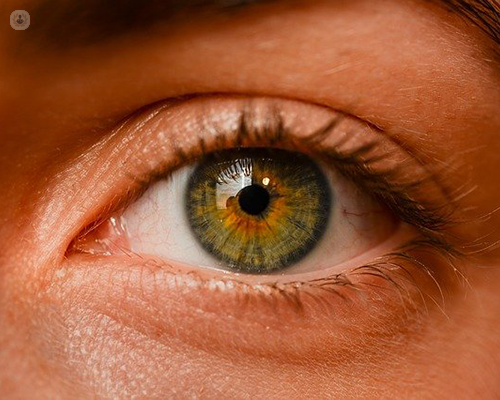7 signs your sight may be failing
Written by:As with all parts of the body, ageing takes its toll on the eyes and many people notice a mild deterioration in their vision over the years. For many people, especially those in their early forties and onwards, this comes in the form of presbyopia, where the eye isn’t able to focus as well as it once did on close objects. A prescription for reading glasses can easily remedy this but there are a number of other signs of deterioration in vision quality that may need to be further investigated by a specialist. In this article, highly esteemed optometrist Mr Robert Longhurst expertly outlines seven signs of sight deterioration to look out for.

1. Flashing lights and floaters
Eye floaters, medically referred to as myodesopsia, are so called because they float across your field of vision as you move your eyes. They can take different forms, such as lines, dots or squiggles. They are not always a cause for concern and are caused by the breakdown of the jellylike vitreous humour.
However, a marked increase in eye floaters and flashes of light in your peripheral vision can be signs of vitreous detachment, which requires specialist treatment. This complication, where the vitreous becomes smaller and moves away from the retina, isn’t always dangerous but in some cases a tear may occur. This can cause blindness and so prompt treatment is essential.
2. Straight lines appearing wavy
Metamorphopsia, where straight lines appear wavy, can be a symptom of the onset of age-related macular degeneration. It occurs when the layers of the retina become displaced, causing the distortion in vision.
Age-related macular degeneration (AMD) affects the central part of your vision. AMD has two types; wet and dry.
Dry AMD is more common and is currently untreatable, but the development of the condition is very slow so its symptoms are easier to manage.
Wet AMD, on the other hand, has a far faster progression. It causes the production of new blood vessels which leak under the retina, causing very sudden loss of sight. This can become permanent if the patient doesn’t receive treatment.
3. Sudden blind spot in one eye
A blind spot that appears suddenly in one eye can be a sign of a macular hole, found in the middle part of the retina (the macula). The cause behind the formation of macular holes is usually unclear but it is known that women over sixty are the most commonly affected.
The early onset sign of a macular hole is blurry or distorted vision which is not helped by wearing glasses. Over time, the hole fully develops, leading to a blind spot in the central area of the field of vision. Although macular holes sometimes heal on their own, surgery is usually required. If left untreated, the hole will continue to affect vision and may eventually cause a retinal detachment and subsequently, a full loss of sight in the eye.
4. Sudden loss of vision
Whether brief or long lasting, any sudden loss of sight should be medically investigated promptly. Although not always the case, some of the causes of sudden vision loss are very serious so a specialist doctor should be consulted urgently to determine the cause.
One cause of sudden sight loss is a retinal migraine, which is thought to be caused by spasming of one of the eye’s blood vessels. Patients who suffer retinal migraines do not always experience a headache along with the sight loss. This is sometimes referred to as a ‘silent migraine’.
A lack of blood flow to the retina, known as amaurosis fugax can also be the cause behind sudden sight loss. Normally, the blood flow is blocked by a small blood clot at the back of the eye that may have come from the heart or the neck. This type of sight loss is indicative of a forthcoming stroke.
An inflammation of the lining of the head’s arteries, giant cell arteritis (GCA), can also be responsible for a sudden loss of vision. Additional to the loss of sight, patients often experience fatigue, jaw pain whilst chewing and tenderness of the scalp. Prompt treatment for GCA is crucial, as if left untreated, it can cause permanent sight loss.
Trauma to the eye or diabetes can cause detachment of the retina or a bleed inside one of the eye’s cavities (vitreous haemorrhage).
5. Gradual loss of vision
Usually, a gradual loss of vision quality is merely part of the ageing process and regular trips to the optician can help patients to manage this with glasses or contact lenses. As well as determining your prescription, your optician can determine if the cause of your loss of vision quality is something more serious than normal degeneration caused by ageing.
A clouding of the eye’s lens, known as cataracts, is a common condition related to ageing, some types of medication and trauma. Cataracts are often found in patients whose eyes are not helped by glasses and can be corrected by surgical replacement of the affected lens within the eye.
Glaucoma is a more serious cause of gradual vision loss. Unfortunately, by the time the loss of sight is apparent, the condition has passed the treatable phase, meaning it is often called the ‘silent thief of sight’. For this reason, it is important to have your eyes tested at least once every two years after reaching the age of forty and even more crucially, anyone with a family history of glaucoma should undergo an eye test yearly.
6. A painful eye
Pain in the eye has many causes, some more serious than others. For this reason, it is important to see a doctor if this is something you are experiencing. The most common cause of pain in the eye is dry eye, which can also affect vision. Eye drops, however, are usually enough to alleviate the discomfort of the condition.
Other common causes for eye pain are:
- injury
- infection
- inflammation
- the presence of a foreign body
The cornea, the eye’s clear, exterior layer, can sustain scratches which, despite being very painful, don’t usually need any type of treatment and will heal of their own accord. Infections of the cornea, however, can result in permanent sight loss if they are left untreated. In very rare cases, tumours can be the cause of eye pain.
7. Red eye
Similar to pain in the eye, redness can have numerous causes so you should seek an appointment with a specialist to assess your eye health.
Conjunctivitis, an infection of the membrane that covers the eyelid and eyeball, is a common cause of redness in the eye. It is easily treated and doesn’t have long-lasting effects on the eye. Uveitis is an inflammation of the middle layer of the eye which can also cause redness. In some cases, it can lead to further problems, such as cataracts and glaucoma but in the majority of cases, treatment with steroids resolves the issue.
Perhaps the most serious cause of redness in the eye is scleritis, an inflammatory disease that affects the eyeball’s white, outer surface (the sclera). It is very rare, but can cause permanent sight loss if left untreated.
Anyone over forty years old should ensure they have regular eye tests to keep track of their eye health and monitor any changes. If you notice anything unusual between tests, it is important that you report your symptoms to your optometrist so that they can make the necessary investigations.
If you would like to book an appointment with Mr Longhurst to discuss your eye health, you can do so by visiting his Top Doctors profile.


